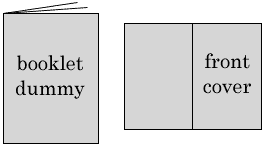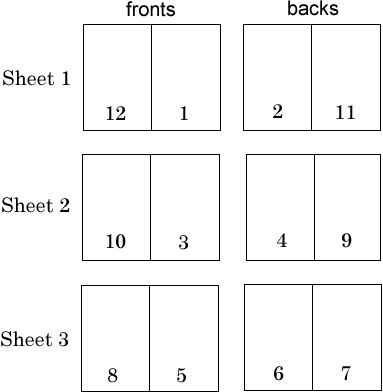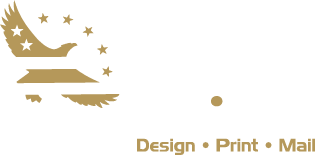
PRINTING INDUSTRY FAQs
We've put together this mini-guide as an introduction to the world of printing. Let us know if you find the information useful. We'd also like to hear your suggestions or questions: please send e-mail to info@casgraphics.com. As you browse through the following Printing FAQs pages, just press the back button on your browser to return here.
DESIGNING BOOKLETS
GUIDELINES FOR DESIGNING
A PRESS-READY BOOKLET
Start by examining a previously printed sample for specifications and measurements, or revise and redesign to meet your current needs. Ask yourself:
a. If the type is a readable size and style
b. If the booklet format is easy to read and follow
c. If the size of the book is suited to its current uses
Choose a common, practical, economical size:
a. 5½" x 8½" page size
b. 8½" x 11" page size
c. 8½" x 4" page size (this fits in a No. 10 business (envelope for mailing)
Design pages to have at least 2-pica margins (1/3 inch), and at least ½" to 1" margins for larger pages.
If setting your own type using desktop publishing, completely set all text into pages with the type measurements and page margins chosen. Watch page breaks so that no headlines appear at the bottoms of any pages.
Make a dummy by counting the number of pages of text, including blank pages after title pages, contents, sections, etc. Take the total number and divide by 4. If there is any remainder, add blank pages to the total number of pages (and to the end of your book) so that your number is evenly divisible by 4. This number equals the number of sheets of paper in the text of the finished book.
Use small sheets of paper to make an actual dummy, folding them as you would to create the printed book, adding a sheet for the cover, and then numbering and labeling each page as it will appear in the printed book, including blanks. Taken apart, these sheets will show the arrangement of the pages necessary to print the book. Note the example below for a 12-page book with a colored cover.
A 12-page booklet dummy will have a cover, plus 3 text sheets, with pages arranged as shown above.


PROOFREADER'S MARKS
Punctuation Marks:






Period
Comma
Semicolon
Colon
Apostrophe
Open Quotes






Close Quotes
Question Mark
Exclamation point
Hyphen
Parentheses
Dash
GLOSSARY OF TERMS
GLOSSARY OF PRINTING TERMS
A | B | C | D | E | F |G | H | I | J | K | L |M | N | O | P | Q | R |S | T | U | V | W | X |Y | Z
A
accordion fold paper fold using two or more parallel folds which open like an accordion.
against the grain folding or feeding paper at right angles to the grain direction of the paper.
antique finish a term for the surface texture of some cover papers that is natural and slightly rough.
art all kinds of illustration copy used in preparing a job for printing. Also used to describe the paste-ups themselves.
ascender the part of a lower case letter which rises above the main body, as in "b".
B
bleed the effect created when the image extends beyond the edge of the sheet or page of a printed piece.
body type the style and size of type used for the main text of a printed piece as distinguished from the headlines, etc.
bond paper a grade of strong but lightweight paper designed for printing on one side, commonly used for stationery, business forms, and copying.
burn a common term to describe the exposure of a plate to bright light when it is being made.
C
camera-ready art describes copy for printed material that is ready to be photographed for reproduction.
center marks small black lines near the edges of camera-ready copy which indicate the midpoint measurements of the finished piece.
coated paper paper having a surface coating which produces a smooth finish. The finish may be dull or glossy; both give the ink a brighter appearance. Often used for printing full color photographs.
collate in binding, gathering the sheets or pages of a publication to be stapled folded, etc.
color key a pre-press proof using transparent films of various colors to represent the ink colors used for the printing process. Simulates finished product when full-color photographs are being printed, or several ink colors, special screening effects, etc.
color separation the process of photographically separating colored art or photographs into primary color components (negative or positive) for printed reproduction.
cool colors greens, blues, purples and other colors that have a predominantly bluish cast, as opposed to warm colors which have a predominantly yellowish or reddish cast.
continuous tone a photographic image or illustration which contains shades of gray in addition to black and white.
copy any furnished material (typewritten manuscript, pictures, artwork, etc.) to be used in the production of printing.
copyfitting the calculation of how much space a given amount of copy will take up in a given size and typeface. Also, the adjusting of the type size to make it fit in a given amount of space.
cover paper the term for a variety of heavier weight papers used for booklet covers, brochures, etc.
D
descender the part of a lower case letter which extends below the main body, as in "p".
die-cutting the process of using specially designed cutting tools to create custom shapes or cutouts in printed materials.
dummy a preliminary layout showing the position of illustrations and text as they are to appear in the final printed piece. Also a set of blank pages made up in advance, marked to show the size, shape, form or page arrangement of the printed piece.
duotone the term for a two-color halftone made from a one-color photograph.
duplex paper paper with a different color or finish on each side.
E
F
filling in a condition where ink fills the area between the halftone dots or plugs up the type.
flush left (or right) type set to line up at the left (or right)
font a complete assortment of letters, numbers, punctuation marks etc., of a given style and size.
G
galley proof a proof of text copy only, before it is made into pages with other art elements.
generation each succeeding stage in reproduction from the original copy.
grain in papermaking, the direction in which most fibers lie, which corresponds with the direction the paper is formed on the mill machinery. Paper folds easily when folded with the grain and it folds poorly and creates a rougher edge when folded against the grain.
gripper margin an unprintable blank edge of paper on any printed item which the press holds onto as it prints the sheet. Usually less than ½ inch.
gutter the blank space between columns of type or the inner margin between the print and the binding of a book.
H
halftone the reproduction of continuous-tone artwork, such as a photograph, using a contact screen over the film which converts the image into black and white dots of various sizes.
hardcopy the printout of a computer file or the typewritten copy submitted to a printer to be typeset.
high contrast in photography or illustration, a reproduction in which light and dark areas are more exaggerated than in the original object or image.
highlight the lightest, brightest part of a photograph or half-toned image.
I
italic the style of letters that slant, in distinction from upright or roman letters. Used for emphasis in text.
J
justify in setting type, to space out lines uniformly to the correct length.
K
L
laid finish paper with a pattern of parallel lines at equal distances, giving a ribbed effect.
lamination a plastic film bonded by heat and pressure to a printed sheet for protection or appearance.
layout the drawing or sketch of a proposed printed piece.
leading the distance between lines of type, measured in points. 1 point=1/72 inch.
line copy any copy suitable for reproduction without using a halftone screen.
M
matte finish dull finish on coated paper, lacking gloss or luster
mechanical or paste-up terms for a camera-ready paste-up of artwork. It includes type, photos, line-art, all attached to one sheet or matte board.
middle tones the gray areas (as opposed to the black and white areas) of a photograph or illustration.
moiré the undesirable screen pattern caused by incorrect screen angles or overprinting halftones.
N
O
offset lithography the printing process used by presses which transfer the image from a plate, to a rubber blanket and then onto a sheet of paper.
original the number of pages (if a large book), the number of names (if business cards), or the number of camera-ready mechanicals to be reproduced.
overlay a transparent covering over a artwork that indicates color designations and other instructions to the printer. Also, transparent layers of artwork which are overprinted to create a composite image.
overrun in printing, copies printed in excess of the specified quantity.
P
PMS# (ink color) Pantone Matching System color; the number indicates one of a set of standard formulas for mixing ink colors, used by all printers.
PMT\PhotoMechanicalTransfer a photographic paper reproduction of a black and white image, taken by a printer's camera.
pagination in typesetting or paste-up, the process of breaking copy into pages of a specific dimension.
paste-up 1) to combine art elements (type, illustrations, lines, photographs, etc.) into a unified whole, using manual tools and wax/adhesives or using a computerized system to manipulate and combine the art elements into a whole page.2) same as "mechanical" - the term for a camera-ready piece of artwork, including type, photos, line art, all attached to one sheet or matte board.
perfect bind assembly of a whole book by gluing the trimmed pages to a wrap-around cover in paperback fashion
pica a printer's measurement, equal to approximately 1/6th of an inch.
point a printer's measure for type specifications. There are 12 points in a pica and 72 points in an inch.
process colors yellow, magenta, cyan (blue) and black, the four colors of ink used by printers for full color reproduction of color art.
proof a facsimile of the printed item prepared during various stages of the process for the customer's approval.
punch (also drill) to place holes in paper (as for use in notebooks, binders, etc).
Q
R
ragged left/right a column of type set to line up evenly on one side, but remaining uneven on the other.
register in printing, to fit two or more printed images in exact alignment with each other.
register marks distinctive symbols placed on the outer edges of artwork before photographing. Used to help plate makers and press operators align copy in two or more colors of ink.
resolution in typesetting, the quantification of type quality using number of dots per square inch.
run-around description of type, aligned to fit around a picture or other element of the design.
S
saddle stitch to fasten a booklet by stapling it through the middle fold of the sheets.
score to make an indentation in paper before folding to make it fold more easily.
screen to reproduce a shaded area in a printed piece. Also, a photographic tool for making halftone images from a continuous tone photo or illustration.
serif the short, cross-lines at the ends of many letters in some typestyles.
shadow the darkest portion of a photograph, as opposed to the highlights.
signature the name given to a folded, printed sheet containing several pages of a book, before it is assembled as part of the book.
spine the rigid part of a bound book, where the covers and pages are joined.
spiral binding a book-binding method with spiral wires inserted through small holes punched along the binding side.
stripping the positioning of negatives or positives on a flat sheet to prepare them for creating a plate.
T
text the main body of typewritten words on a page as opposed to the headlines, or captions.
tissue overlay a thin, translucent paper placed over artwork for protection; may also be used to mark corrections or printing instructions, ink colors, etc.
trim marks/corner marks marks placed on the copy to indicate the edge of the page
U
V
varnish a thin, protective coating applied to a printed sheet for protection or to add a glossy appearance.
vellum finish in papermaking, a toothy finish which is relatively absorbent for fast ink penetration.
velox a positive, photographic paper image in black and white created from a negative.
W
warm colors reds, yellows, and oranges, or other colors that have a predominantly yellowish or reddish cast.
wash-up cleaning ink off parts of a press so that a different color of ink can be applied.
web press a press which prints on continuous rolls or paper rather than separate sheets.
widow in typesetting, a single word in a line by itself, ending a paragraph; considered poor style.
work and tumble to print one side of a sheet of paper, then turn it end to end, changing the gripper, and printing the other side.
work and turn to print one side of a sheet of paper, then turning it over from left to right, keeping the same gripper edge going through the press as the second side is printed.
wove finish paper having a uniform, unlined surface and a soft, smooth finish.
X
Y
Z
